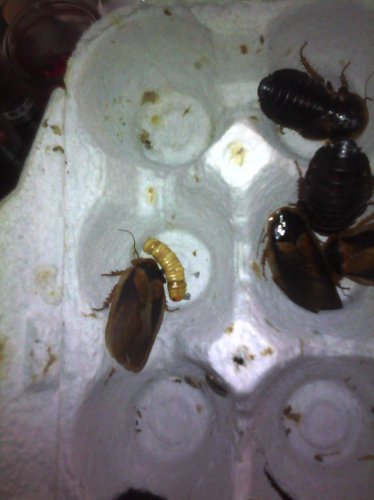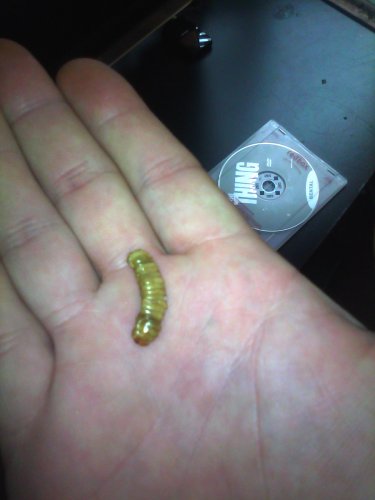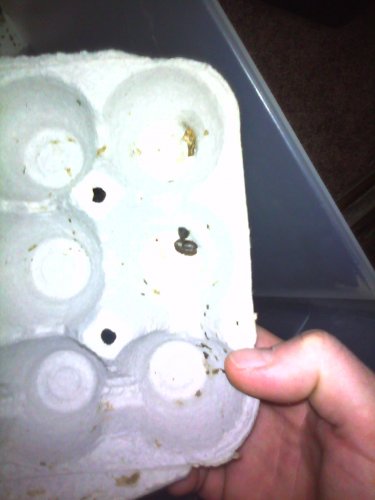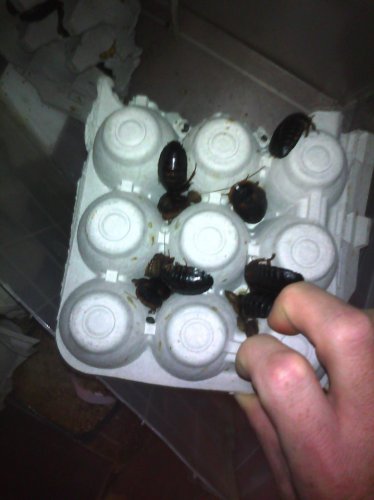Navigation
Install the app
How to install the app on iOS
Follow along with the video below to see how to install our site as a web app on your home screen.
Note: This feature may not be available in some browsers.
More options
You are using an out of date browser. It may not display this or other websites correctly.
You should upgrade or use an alternative browser.
You should upgrade or use an alternative browser.
B.Dubia breeding and reproduction question..
- Thread starter JonRich
- Start date
amanda509
New Member
im curious as to why it extends the eggs at all IF mating is internal? maybe its a way to regulate the temps, if it gets too hot, its extended, if its cold, its kept inside...im quite curious  wouldnt it be pointless to lay the eggs and suck them back in if nothing is done to them, unless theyre moving them to another area where they will be incubated and formed, other than the area they were made?
wouldnt it be pointless to lay the eggs and suck them back in if nothing is done to them, unless theyre moving them to another area where they will be incubated and formed, other than the area they were made?
sdheli420
Avid Member
Im starting to really wonder how the hell they do it
this is what i see
i keep finding ooths that have been dropped..i see them for about a day, then they dissapere, and about two or three weeks later i see more nymphs..so im assuming they drop the ooth for fertilization?? im still confused on how, and why..
heres the pics i got..
1st pic is ooth with a male near by.
2nd is the ooth it self..in good condition..no bites or anything
3rd is a pile of nymphs
4th is just the group i have
this is what i see
i keep finding ooths that have been dropped..i see them for about a day, then they dissapere, and about two or three weeks later i see more nymphs..so im assuming they drop the ooth for fertilization?? im still confused on how, and why..
heres the pics i got..
1st pic is ooth with a male near by.
2nd is the ooth it self..in good condition..no bites or anything
3rd is a pile of nymphs
4th is just the group i have
Attachments
patrickfraser
New Member
Dubias mate and are fertilized internally. The ootheca is formed and then it is released to be sucked back into the "incubating chamber". I believe the exposure of the ootheca is to regulate the temps. I also believe if one is found "loose", it is most likely infertile. If it "disappears", it was probably eaten. I read once mated, the female cannot mate with another male. something about the male "plugging" her up or something and she will no longer be receptive to other males, until after the birth.
JonRich
New Member
Dubias mate and are fertilized internally. The ootheca is formed and then it is released to be sucked back into the "incubating chamber". I believe the exposure of the ootheca is to regulate the temps. I also believe if one is found "loose", it is most likely infertile. If it "disappears", it was probably eaten. I read once mated, the female cannot mate with another male. something about the male "plugging" her up or something and she will no longer be receptive to other males, until after the birth.
Thanks, seems spot on.. I also found this on the internet.
"Lifecycle:Mating occurs when the male deposits a sperm packet in the female. This sperm packet inhibits the female from further mating.
Females then lay an egg sack, they then pull this sack back into themselves to incubate ovovivoparitally.
Gestation is about one month (28 days).
The babies hatch inside the female. Between 20 and 40 live young, each about 2 mm long, are produced in each clutch.
Babies mature in about 4–6 months depending on temperature and food supply.
Adults live 1–2 years."
sdheli420
Avid Member
Thanks, seems spot on.. I also found this on the internet.
"Lifecycle:Mating occurs when the male deposits a sperm packet in the female. This sperm packet inhibits the female from further mating.
Females then lay an egg sack, they then pull this sack back into themselves to incubate ovovivoparitally.
Gestation is about one month (28 days).
The babies hatch inside the female. Between 20 and 40 live young, each about 2 mm long, are produced in each clutch.
Babies mature in about 4–6 months depending on temperature and food supply.
Adults live 1–2 years."
well i understand now..soo weird..im amazed they are soo easy to breed and they do all that work..
patrickfraser
New Member
My colony is starting to really explode since I moved them to a smaller bin and upped the temp a bit. Not much to do for them, except provide heat and food.
JonRich
New Member
So i have had about 100 or so nymphs born this week alone (that u witnessed) and no signs of the births stopping..
Little video of one of the 4-5 females that gave birth this week.
http://www.youtube.com/watch?v=JWVcjWD8ciM&feature=youtube_gdata_player
and another
http://www.youtube.com/watch?v=uFnLFWxpUao&feature=youtube_gdata_player
Little video of one of the 4-5 females that gave birth this week.
http://www.youtube.com/watch?v=JWVcjWD8ciM&feature=youtube_gdata_player
and another
http://www.youtube.com/watch?v=uFnLFWxpUao&feature=youtube_gdata_player
Solid Snake
Avid Member
Nice.
Your chameleon looks good man!
Ive yet to find any fresh nymphs like that.
By the time I see them they are dark and scattered everywhere...
Your chameleon looks good man!
Ive yet to find any fresh nymphs like that.
By the time I see them they are dark and scattered everywhere...
JonRich
New Member
Nice.
Your chameleon looks good man!
Ive yet to find any fresh nymphs like that.
By the time I see them they are dark and scattered everywhere...
How big is your colony, adult wise?
Salty
New Member
pervert....
lmao!!!!!!!
DragonRescuer22
New Member
Hi,Ok well everything I read states that B.Dubia give live birth to their nymphs.
Well I have never witnessed this, but I do see clusters of fresh white nymphs when cleaning the bin sometimes.
I have been seeing a few females with what looks like a egg case attached to their rear. I caught one once and places her into a deli cup to try to observe first hand what would come of the egg case. I woke up the next morning and could not find any egg case, nor did I find any nymphs. My only conclusion was that she ate it/them.
Well I got a pic of one last night.
Can someone explain what exactly that "egg case" is? and how reproduction works with B.Dubias . Do they emerge from this "egg case", or do they give birth one by one to live nymphs?


This is called thermo-regulation.
The female dubia coolscthecegg case off from time to time during the incubation. It is normal behavior.
MissSkittles
Chameleon Enthusiast
Hi and welcome!Hi,
This is called thermo-regulation.
The female dubia coolscthecegg case off from time to time during the incubation. It is normal behavior.
DragonRescuer22
New Member
Hi,Hi and welcome!That is interesting to know (I’ve seen my discoid with their egg case sticking out), but this thread is ten years old. The op hasn’t been active since 2015. However, we always need knowledge about our feeders.

I noticed that after I posted.
Take care
dinomom
Chameleon Enthusiast
If you stress them as when cleaning the bin they sometimes drop the case. That's a waste obviouslyAhhh!! Thanks all!!
This explains why there was no trace of the ooth from the female i took out and placed into the Deli cup. I just thought she ate it.
You learn something new everyday. This i didn't know about the sucking it back in to incubate deal.
Similar threads
- Replies
- 8
- Views
- 1K
















